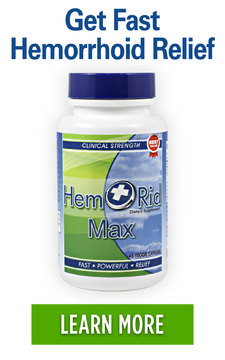Vaginal Hemorrhoids – What Does a Prolapse Look Like?
Posted on 14 November 2018 by Maryanne Johnson
Share this post
Hemorrhoids find its highest prevalence among adults between 45 and 65 years of age. This anorectal disorder is one of the biggest complaints in doctors’ offices per year, but in some cases, hemorrhoids can be conflated with other gastrointestinal problems.
Hemorrhoids, although incredibly common, can be misdiagnosed or overlooked. For some patients, especially women, it is unclear if hemorrhoids are the issue or if the problem lies within the vaginal area, such as a yeast infection or other malady.
External and internal hemorrhoids can occur together, and for many hemorrhoid sufferers, they are treated at home without medical advice. This can be a growing problem if other symptoms unrelated to hemorrhoids are also present, like vaginal itching, pain, or swelling.
Although both women and men are essentially statistically equal when it comes to developing hemorrhoids, pregnancy, labor, and vaginal delivery up the numbers, creating a separate hemorrhoid risk factor for women to watch out for.
If you are experiencing vaginal pain or itching as well as hemorrhoids, then let this informative guide answer all of your pressing questions. The anorectal area can affect the vaginal area, and it is essential to know all of your symptoms to establish an effective treatment plan better.
Can Hemorrhoids Cause Vaginal Pain?
Hemorrhoids are known to cause pain and discomfort, but if you are experiencing vaginal pain and hemorrhoids together, you might have more than one condition at the same time.
Hemorrhoids are central to the anorectal area and do cause pain. External hemorrhoids are lumps that form around the anus, but not anywhere close to the genitals. These lumps are the origin of much of the pain experienced by hemorrhoids.
Vaginal pain can occur with hemorrhoids, but it could be another condition. There is a possibility you may have:
- A vaginal infection
- A urinary tract infection
- Endometriosis
- Vulvitis
- A vulvovaginal disorder
It can be easy to conflate the pain of hemorrhoids with the pain caused by a disorder or condition of the vagina. Sometimes, hemorrhoid pain can be difficult to locate correctly, and it could feel like the hemorrhoid pain is coming from the genital area.
To know for sure why you are experiencing hemorrhoid pain and vaginal pain, go and visit your doctor. A quick relay of your symptoms can diagnose your condition, and in many cases, the pain could be from hemorrhoids.
Hemorrhoids and Vaginal Itching
There’s no doubt that hemorrhoids cause intense itchiness. And for most women, vaginal itching is frequently experienced as well. You can certainly have anorectal and vaginal itching occur together.
Hemorrhoids can affect the vaginal area. Their itchiness can seem like a yeast infection, which is why it can be so difficult to determine if you have a vaginal infection or if you have hemorrhoids.
A few other conditions that cause vaginal itching are:
- An adverse allergic reaction
- Lack of estrogen
- A sexually transmitted infection (STD)
- A small cut that can cause itching and irritation
- Yeast infections
- Hemorrhoids
External hemorrhoids cluster around the anus, but that doesn’t mean all of the symptoms affect just this one area. Itching, pain, swelling, and irritation can easily affect the vaginal area.
If you are treating your vaginal itching with topical medications that are meant to resolve it and see no improvement, then you should consider trying some hemorrhoid treatments instead.
There are plenty of hemorrhoid treatments that can also help with vaginal itching:
- Hemorrhoid creams and ointments with anti-itch formulas
- Soaking in a warm sitz bath, submerging the vaginal and rectal area
- Using cleansing wipes with anti-itch formulas
- Inserting a suppository for hemorrhoids
Vaginal Hemorrhoids and Pregnancy
Hemorrhoids occur during pregnancy and most frequently develop during the third trimester. The reason being is that the weight of carrying the baby increases stress and pressure on the lower rectal region. Rectal veins, arteries, and blood vessels respond to the increased pressure by becoming inflamed, leading to hemorrhoids developing more prominently.
Pregnancy is a risk factor for hemorrhoids, and unfortunately for pregnant women, this risk factor is unavoidable. External and internal hemorrhoids can occur together, or women may experience one type at a time.
Hemorrhoids, although located more closely to the anus, can affect the vaginal area, too. During pregnancy, women might find that with hemorrhoids, both the vaginal area and rectal area swells, itches, and is tender or aching.
Hemorrhoids are common, and because they are widely experienced, many at-home remedies have been discovered and used to relieve the symptoms caused by pregnancy hemorrhoids.
Safe and effective ways to treat vaginal hemorrhoids during pregnancy include:
- Cleansing the vaginal and rectal area with mild soaps
- Using a lukewarm sitz bath to reduce swelling and other symptoms
- Taking a natural hemorrhoid supplement
- Eating more fiber
- Taking a fiber supplement
- Using Tucks Wipes
- Applying Preparation H
- Using on a hemorrhoid cushion for sitting
For vaginal hemorrhoids and pregnancy, however, women should check with their doctors before trying any medications or treatments.
Hemorrhoids and Vaginal Pain
Your vaginal pain can mean the presence of hemorrhoids or another condition that is causing pain and discomfort.
Rectoceles, like hemorrhoids, are a common disorder that can cause vaginal pain. A rectocele is a herniation of the rectum into the vaginal wall, where the result is a vaginal bulge.
For many women with rectoceles, there are no symptoms. Others complain of perineal and vaginal pressure, trouble passing stools during a bowel movement, constipation, and hemorrhoids. Hemorrhoids, of course, come with a whole set of their unique symptoms on top of those experienced from a rectocele.
Hemorrhoids can cause:
- Swelling and inflammation in the vaginal or rectal area
- Itching, anal or vaginal itch
- The development of anal masses clustered near the anus
- Pain and a feeling of burning in both the vaginal or rectal area
- Anal discharge
- Difficulty going to the bathroom
- Feeling uncomfortable sitting down or standing
With hemorrhoids, sufferers report straining or constipation in their toilet habits. An irregular or constipated bowel can worsen hemorrhoids and is often found to be the leading cause of their development.
The symptoms of hemorrhoids are not just local to the anal area. And with hemorrhoids arising from vaginal conditions, it can be incredibly difficult to diagnose the real problem at hand.
It is best to visit your doctor about vaginal pain in combination with hemorrhoids. The hemorrhoids could be a secondary reaction to another condition, like rectoceles.
Hemorrhoids After Vaginal Delivery
Like pregnancy, labor is a risk factor for hemorrhoids. The intense straining caused by labor undoubtedly causes hemorrhoids to develop because of the stress placed upon the network of rectal veins.
Straining, either from labor or constipation, is one of the most common factors that cause hemorrhoids. Unfortunately, there is little that can be done about straining during labor, and most women develop hemorrhoids with vaginal delivery.
After giving birth vaginally, external hemorrhoids are at their worst, some even becoming thrombosed. There are creams, and ointments women can use to help subside symptoms of hemorrhoids postpartum.
By keeping the vaginal and rectal area clean after vaginal delivery, you can prevent hemorrhoids from worsening and manage symptoms. Also, eating lots of fiber from whole foods can make it easier to pass stools, lessening straining on the toilet, and helping to shrink hemorrhoids.
Can Vaginal Sex Cause Hemorrhoids?
Vaginal sex doesn’t cause hemorrhoids, but it can aggravate them. Sexual intercourse increases blood flow to the pelvic floor muscles, and for the anal area, this also means an increase in pressure.
For many hemorrhoid sufferers, vaginal or anal sex can be a trigger to hemorrhoid flare-ups, but other causes can contribute to a hemorrhoids, like constipation, lifting heavy objects, sitting or standing for long periods of time, and pregnancy.
Flare-ups can occur because of the stress on the veins working to push blood to the anal and vaginal area. Anal sex can especially cause flare-ups to happen.
Some doctors will suggest you avoid sex during a hemorrhoid flare-up. Managing hemorrhoids first while not engaging in sexual intercourse can help shrink the hemorrhoids and control symptoms.
Conclusion
Taking oral pain relievers, using topical ointments, and soaking in a warm sitz bath can help make the symptoms of a hemorrhoid flare-up more tolerable. You can also apply a cold pack to the anal or vaginal area to reduce swelling, itching, and burning.




0 comments